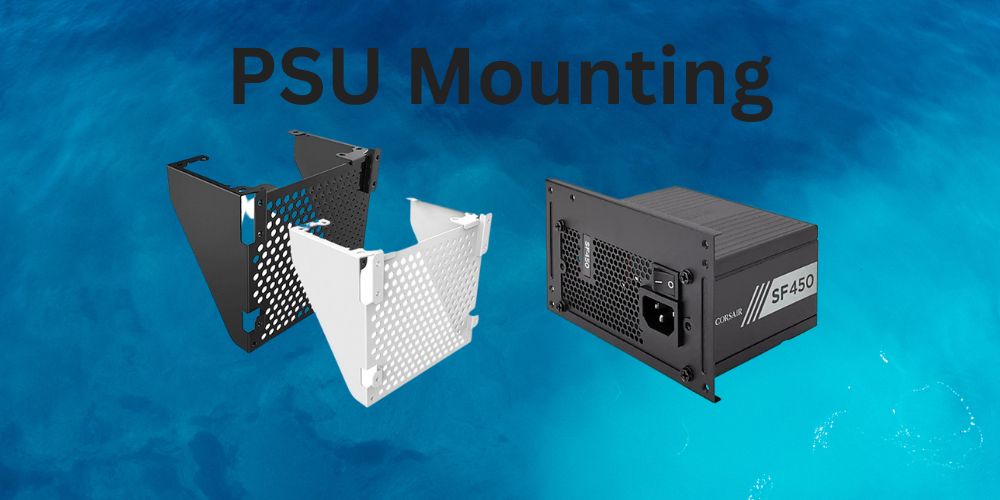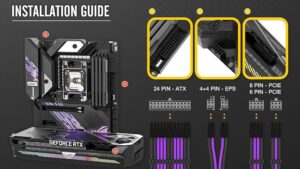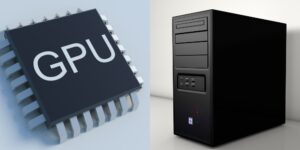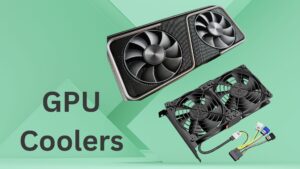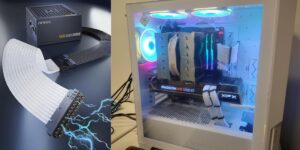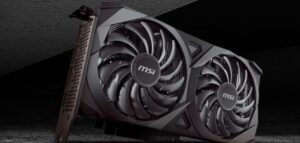Which Way To Mount PSU? Optimizing PSU Cooling
When building or upgrading a PC, the proper mounting of the power supply unit (PSU) is a crucial step that often gets overlooked. The orientation and positioning of the PSU can have a significant impact on the overall cooling efficiency and performance of the system. Factors such as airflow, dust accumulation, case design, and exhaust direction must be carefully considered to ensure optimal PSU operation and longevity. Mounting the PSU with the fan facing down is generally preferred, as it allows the unit to draw in cool air from outside the case and expel hot air efficiently. However, this configuration may not always be suitable, depending on the specific case design and placement. In this comprehensive guide, we will delve into which way to mount PSU orientation, explore the benefits of different choices, and help you make an informed decision that aligns with your PC’s needs.
Which Way to Mount PSU: Intake or Exhaust?
The first decision you’ll need to make is to mount your PSU with the fan facing up (intake) or down (exhaust). Whether to mount the PSU as an intake or exhaust depends on your case’s airflow and environment. If your case has good bottom ventilation and sits on a hard surface, intake mounting can draw in cool air efficiently, aiding PSU cooling. However, if your case has poor ventilation underneath or sits on the carpet, intake mounting may lead to dust buildup and hinder cooling.
Alternatively, exhaust mounting expels warm air from the case, potentially reducing overall system temperature. Consider factors like case design, airflow patterns, and environmental conditions to determine the most suitable mounting direction for optimal performance and longevity. Before we explore the nuances of how to mount your PSU, let’s understand the primary orientations and their implications.
Mounting PSU with Fan Facing Up (Intake):
Mounting the power supply unit (PSU) with the fan facing up is a debated topic among PC builders. The orientation of the PSU fan can impact airflow and cooling efficiency within the system. When the fan faces up, it draws air from inside the case and exhausts it out the back. This configuration can be suitable if the case lacks ventilation at the bottom or if the PC sits on carpeted flooring, where drawing air from the bottom could lead to dust accumulation. While having the fan face up may not significantly affect the performance of other components, it is essential to ensure proper airflow and cooling to maintain optimal system operation. Ultimately, the decision to mount the PSU with the fan facing up should consider factors like case design, airflow requirements, and environmental conditions to ensure efficient cooling and system longevity.
Different Ways to Mount a PSU With The Fan Facing Up:
The different ways to mount a power supply unit (PSU) with the fan facing up include:
Mounting PSU with the fan facing up on a carpeted floor:
- This configuration is suitable for cases where the computer sits on a carpeted floor. The fan draws in air from inside the case, which can be beneficial in reducing dust accumulation and ensuring optimal airflow.
PSU with fan facing up in an enclosure:
- This configuration involves mounting the PSU in an enclosure or a separate compartment within the case, ensuring that the fan draws in air from inside the case and exhausts it out the back.
A PSU with fan facing up on a hard surface:
- This configuration is suitable for cases where the computer sits on a hard surface. The fan draws in air from inside the case, which can be beneficial in ensuring optimal airflow and reducing dust accumulation.
PSU with fan facing up in a case with a grill on the bottom:
- This configuration involves mounting the PSU in a case with a grill on the bottom, allowing the fan to draw in air from inside the case and exhaust it out the back.
A PSU with the fan facing up in a case with a top-mounted PSU:
- In cases where the PSU is top-mounted, having the fan face up can help draw in cool air from inside the case and exhaust it out the back, ensuring efficient cooling
Benefits of Mounting PSU Intake:
The benefits of mounting the PSU intake include:
Improved Cooling:
- Mounting the PSU intake allows the unit to draw in cooler air from outside the case, enhancing overall cooling efficiency and helping maintain lower internal temperatures.
Reduced Dust Accumulation:
- By positioning the PSU intake to draw air from outside the case, the risk of dust buildup within the system is minimized, leading to cleaner components and potentially extending the lifespan of the PSU.
Optimal Performance:
- Ensuring that the PSU intake has access to fresh, cool air helps maintain stable operating temperatures, which is crucial for the PSU’s performance and longevity.
Separate Airflow:
- Having the PSU intake its own air supply and exhaust it out the rear of the case creates a separate cooling system that is not dependent on the internal case airflow, contributing to better thermal management and system stability.
Prevention of Overheating:
- Properly mounting the PSU intake ensures that the unit can operate efficiently without being starved of cool air, reducing the risk of overheating and potential performance issues
Mounting PSU with Fan Facing Down (Exhaust):
Mounting the power supply unit (PSU) with the fan facing down allows the PSU to draw in cool air from outside the case and exhaust it out the back, which can be beneficial for maintaining optimal system performance and longevity. When the fan faces down, it draws in air from the bottom of the case, which can be particularly useful if the case lacks ventilation at the bottom or if the PC sits on carpeted flooring, where drawing air from the bottom could lead to dust accumulation. This configuration aids in the unit drawing in much-needed cool air when under load, which is essential for optimal performance and prolonging the life of the unit3. Additionally, having the PSU fan facing down can help reduce the risk of dust accumulation and ensure that the unit operates efficiently.
Different Ways to Mount a PSU With The Fan Facing Down:
The different ways to mount a power supply unit (PSU) with the fan facing down include:
Bottom-mounted PSU with fan facing down:
- This is a common configuration where the PSU is mounted at the bottom of the case and the fan draws in air from outside the case, exhausting it out the back.
PSU with fan facing down in an enclosure:
- This configuration involves mounting the PSU in an enclosure or a separate compartment within the case, ensuring that the fan draws in air from outside the case and exhausts it out the back.
A PSU with fan facing down on a carpeted floor:
- This configuration is suitable for cases where the computer sits on a carpeted floor. The fan draws in air from outside the case, which can be beneficial in reducing dust accumulation and ensuring optimal airflow.
PSU with fan facing down on a hard surface:
- This configuration is suitable for cases where the computer sits on a hard surface. The fan draws in air from outside the case, which can be beneficial in ensuring optimal airflow and reducing dust accumulation.
A PSU with fan facing down in a case with a grill on the bottom:
- This configuration involves mounting the PSU in a case with a grill on the bottom, allowing the fan to draw in air from outside the case and exhaust it out the back.
Benefits of Mounting PSU Exhaust:
The main benefits of mounting the PSU exhaust fan to blow air out of the case are:
Improved airflow and cooling:
- Exhausting hot air from the PSU directly out of the case, prevents the heated air from being recirculated and affecting the cooling of other components.
Reduced dust accumulation:
- Exhausting hot air out of the case minimizes the amount of dust and debris being blown into the case, keeping components cleaner.
Compatibility with bottom-mounted PSU designs:
- In cases with bottom-mounted PSU locations, having the exhaust fan blow downwards allows the hot air to be expelled through the rear of the case.
Optimal heat dissipation:
- Directing the hot air from the PSU out of the case, rather than letting it accumulate inside, helps the PSU operate at lower temperatures and dissipate heat more efficiently.
Consistency with case airflow:
- Aligning the PSU exhaust with the case’s rear exhaust fans creates a more consistent and effective airflow pattern, improving overall cooling.
Also, Check Out.
Top 6 Best Graphics Cards For Transcoding
Factors to Consider When Mounting PSU:
When deciding how to mount your power supply unit (PSU), there are several key factors to consider:
1. Airflow: The most important factor is ensuring adequate airflow for the PSU. If the case has a bottom-mounted PSU, it’s best to have the fan facing down, drawing in cool air from outside the case. This allows the PSU to operate at lower temperatures.
2. Dust Accumulation: Mounting the PSU with the fan facing down can lead to increased dust buildup, as the fan will draw in more dust from the floor. Using a dust filter or elevating the case can help mitigate this issue.
3. Case Design: Some cases may have better airflow and cooling performance with the PSU mounted in a specific orientation. Check the manufacturer’s recommendations for your particular case.
4. Exhaust Direction: Ensure the PSU’s exhaust is aligned with the case’s exhaust fans or vents to create a consistent airflow pattern. This helps hot air exit the case efficiently.
5. Noise: Mounting the PSU with the fan facing up can slightly reduce noise levels, as the fan will not be directly exposed to the case’s interior. However, modern PSUs are generally quiet regardless of orientation.
6. Carpet: If your PC is placed on a carpeted surface, it’s best to mount the PSU with the fan facing up to avoid drawing in dust and debris.
Step-by-Step Guide to Mounting PSU:
Here’s a step-by-step guide to ensure you’re mounting your PSU correctly:
1. Determine the Fan Orientation
- Start by deciding whether you want to use intake or exhaust orientation based on the factors discussed earlier.
2. Check Your PC Case
- Ensure that your chosen orientation aligns with your PC case design and layout. Some cases may restrict your options.
3. Safety First
- Before you begin, unplug your PC from the power source and discharge any static electricity by touching a metal part of the PC case or using an anti-static wristband.
4. Install the PSU
- Carefully slide your PSU into the designated bay, ensuring it’s properly aligned.
5. Connect Cables
- Connect all the necessary power cables to your components, ensuring secure connections.
6. Test the PSU
- Before securing everything, plug in your PC and ensure it powers on as expected. This allows you to spot and address any issues before finalizing the setup.
7. Secure the PSU
- Once you’re confident everything is working correctly, secure the PSU in place, ensuring it’s not blocking airflow to critical components.
Safety Precautions:
The safety precautions to consider when mounting a power supply unit (PSU) include:
1. Disconnecting Power: Before mounting the PSU, ensure the power cord is disconnected to prevent electrical shock or short circuits.
2. Wearing Protective Gear: Wear appropriate protective gear like safety glasses and gloves to safeguard against potential hazards during installation.
3. Grounding: Ensure proper grounding to prevent electric shock and ensure safety during the mounting process.
4. Avoiding Direct Contact: Avoid direct contact with high-voltage areas of the PSU to prevent electrical shock or injury.
5. Following Manufacturer Guidelines: Adhere to the manufacturer’s guidelines and safety instructions provided with the PSU for correct installation and handling.
Common PSU Mounting Mistakes to Avoid:
- Blocking ventilation: Ensure cables or other components don’t obstruct PSU intake and exhaust vents.
- Improper orientation: Mount PSU with the fan facing the correct direction for intake or exhaust based on case airflow.
- Placing on carpet: Avoid placing the case directly on the carpet, as it can restrict PSU airflow and cause overheating.
- Neglecting dust buildup: Regularly clean PSU filters and internals to prevent dust accumulation, which can impede airflow and lead to overheating.
Conclusion
In conclusion, the mounting of a power supply unit (PSU) is a crucial aspect of ensuring optimal performance and longevity of the PSU. Factors such as airflow, dust accumulation, case design, and exhaust direction must be taken into account when deciding how to mount the PSU. Mounting the PSU with the fan facing down is generally preferred as it aids in drawing in cool air and expelling hot air efficiently. However, if the case lacks proper airflow or is placed on carpeted flooring, mounting the PSU with the fan facing up may be more suitable. Ultimately, the orientation of the PSU fan should align with the case’s airflow dynamics to maximize cooling efficiency and system longevity.
FAQs
Q1: Should I mount my PSU with the fan facing up or down?
A1: The choice between mounting the PSU with the fan facing up or down depends on several factors such as case design, airflow with other fans, and the power supply unit itself. If you have enough room between the intake and the floor and your case has a grill on the bottom for a PSU fan to draw air, it’s generally recommended to mount the PSU facing downwards to aid in drawing in cool air when under load.
Q2: Does it matter if my PSU is mounted on carpeted flooring?
A2: Yes, it does matter if your PSU is mounted on carpeted flooring. If you have the PSU fan facing down, it can draw in dust and debris from the carpet, which can lead to dust buildup and potentially harm the PSU.
A3: No, it’s not recommended to mount the PSU with the fan facing a plate of metal. This can lead to poor airflow and potentially harm the PSU. It’s essential to ensure that the PSU intake is facing a cold air source and not towards a metal plate or any other obstruction.
Last Updated on 30 January 2025 by Ansa Imran

Ansa Imran, a writer, excels in creating insightful content about technology and gaming. Her articles, known for their clarity and depth, help demystify complex tech topics for a broad audience. Ansa’s work showcases her passion for the latest tech trends and her ability to engage readers with informative, well-researched pieces.

